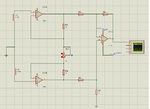pal114525
Member level 5
Hi,
I've designed an Instrumentation amplifier to receive a 20KHz signal from another coil at the Tx side such that this would give ZERO output if there is NO METAL between the TX and RX. And this would give an output voltage if there is any metal in between TX and RX.
Would you please guide me to select the proper values of resistor for that?
Thanks & Regards.
I've designed an Instrumentation amplifier to receive a 20KHz signal from another coil at the Tx side such that this would give ZERO output if there is NO METAL between the TX and RX. And this would give an output voltage if there is any metal in between TX and RX.
Would you please guide me to select the proper values of resistor for that?
Thanks & Regards.



